Financial Reporting: HSBC, Regulatory Framework, and Standards
VerifiedAdded on 2023/01/11
|20
|4904
|1
Report
AI Summary
This report provides an in-depth analysis of financial reporting, focusing on regulatory frameworks, governance, and the purpose of financial reporting within organizations, using HSBC Holdings plc as a case study. The report examines the regulatory frameworks of financial accounting, including IFRS and GAAP, and their importance for transparency and stakeholder trust. It also delves into the purpose of financial reporting in meeting organizational objectives, development, and growth, highlighting the role of financial statements in decision-making and internal control. Furthermore, the report discusses the interpretation of financial statements, including profit & loss, balance sheets, and cash flows, as well as the use of financial ratios for organizational performance and investment analysis. The benefits of International Accounting Standards (IAS) and International Financial Reporting Standards (IFRS) are also explored, along with models of financial reporting and auditing. The report concludes with an evaluation of the differences and importance of financial reporting across different countries, providing a comprehensive overview of the subject matter.

Financial Reporting
Paraphrase This Document
Need a fresh take? Get an instant paraphrase of this document with our AI Paraphraser
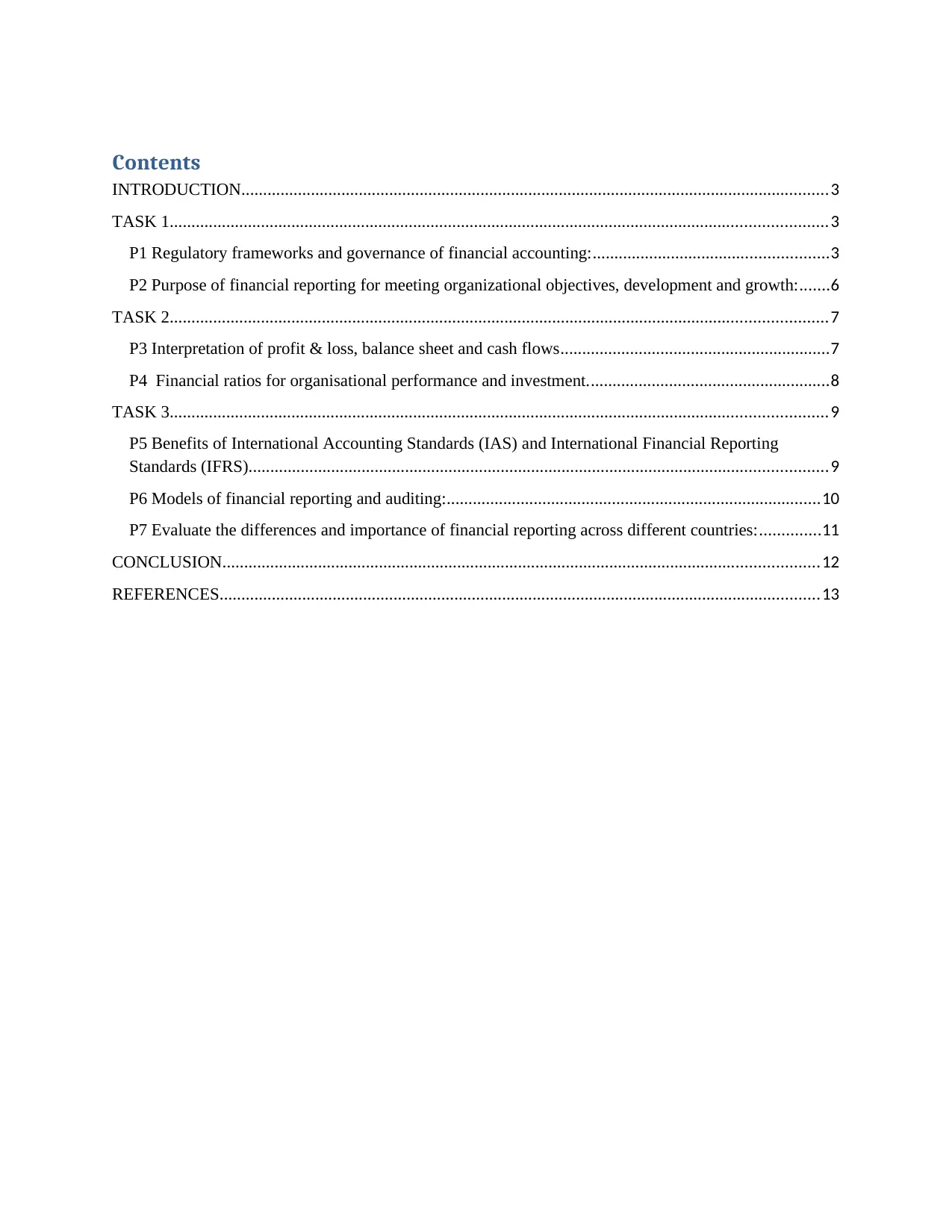
Contents
INTRODUCTION.......................................................................................................................................3
TASK 1.......................................................................................................................................................3
P1 Regulatory frameworks and governance of financial accounting:......................................................3
P2 Purpose of financial reporting for meeting organizational objectives, development and growth:.......6
TASK 2.......................................................................................................................................................7
P3 Interpretation of profit & loss, balance sheet and cash flows..............................................................7
P4 Financial ratios for organisational performance and investment........................................................8
TASK 3.......................................................................................................................................................9
P5 Benefits of International Accounting Standards (IAS) and International Financial Reporting
Standards (IFRS).....................................................................................................................................9
P6 Models of financial reporting and auditing:......................................................................................10
P7 Evaluate the differences and importance of financial reporting across different countries:..............11
CONCLUSION.........................................................................................................................................12
REFERENCES..........................................................................................................................................13
INTRODUCTION.......................................................................................................................................3
TASK 1.......................................................................................................................................................3
P1 Regulatory frameworks and governance of financial accounting:......................................................3
P2 Purpose of financial reporting for meeting organizational objectives, development and growth:.......6
TASK 2.......................................................................................................................................................7
P3 Interpretation of profit & loss, balance sheet and cash flows..............................................................7
P4 Financial ratios for organisational performance and investment........................................................8
TASK 3.......................................................................................................................................................9
P5 Benefits of International Accounting Standards (IAS) and International Financial Reporting
Standards (IFRS).....................................................................................................................................9
P6 Models of financial reporting and auditing:......................................................................................10
P7 Evaluate the differences and importance of financial reporting across different countries:..............11
CONCLUSION.........................................................................................................................................12
REFERENCES..........................................................................................................................................13
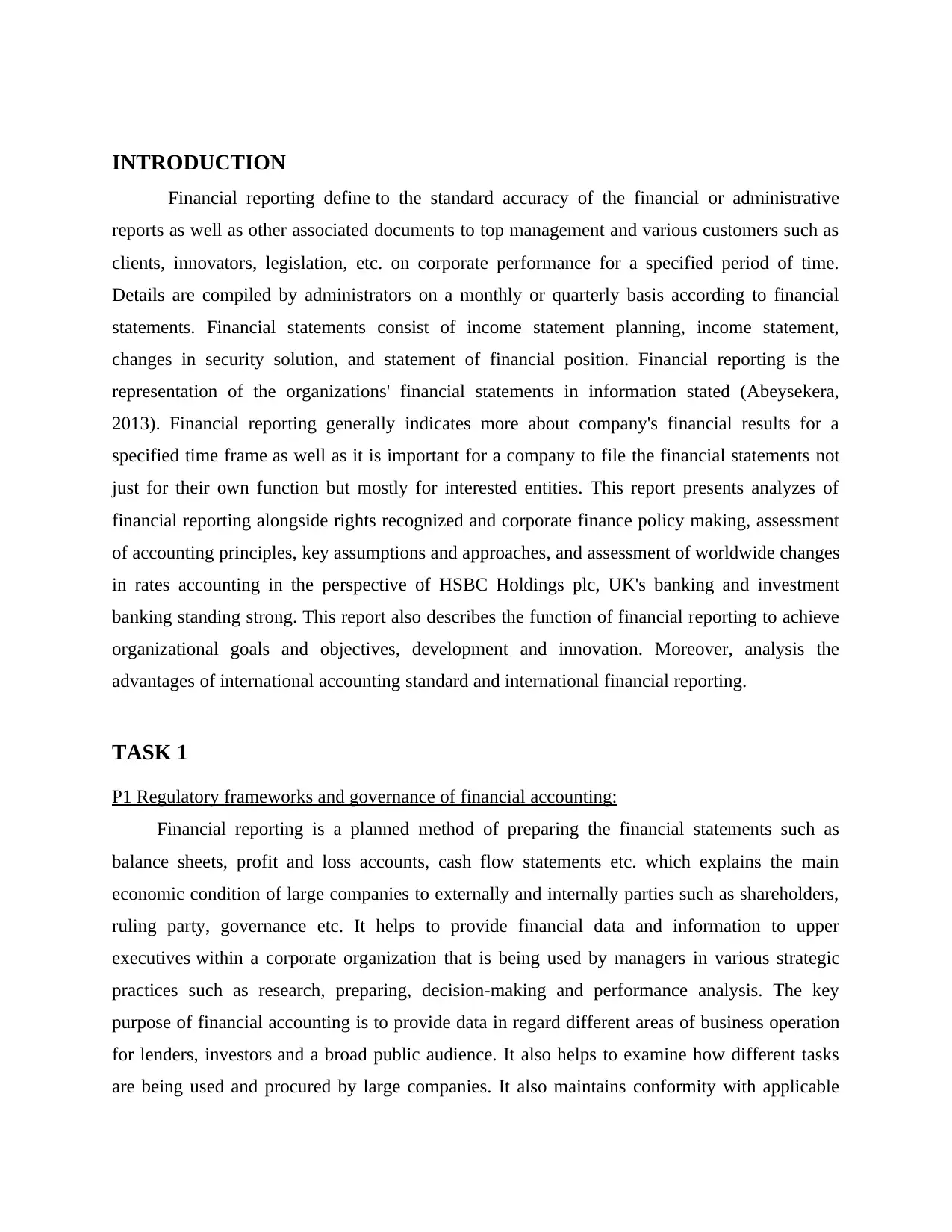
INTRODUCTION
Financial reporting define to the standard accuracy of the financial or administrative
reports as well as other associated documents to top management and various customers such as
clients, innovators, legislation, etc. on corporate performance for a specified period of time.
Details are compiled by administrators on a monthly or quarterly basis according to financial
statements. Financial statements consist of income statement planning, income statement,
changes in security solution, and statement of financial position. Financial reporting is the
representation of the organizations' financial statements in information stated (Abeysekera,
2013). Financial reporting generally indicates more about company's financial results for a
specified time frame as well as it is important for a company to file the financial statements not
just for their own function but mostly for interested entities. This report presents analyzes of
financial reporting alongside rights recognized and corporate finance policy making, assessment
of accounting principles, key assumptions and approaches, and assessment of worldwide changes
in rates accounting in the perspective of HSBC Holdings plc, UK's banking and investment
banking standing strong. This report also describes the function of financial reporting to achieve
organizational goals and objectives, development and innovation. Moreover, analysis the
advantages of international accounting standard and international financial reporting.
TASK 1
P1 Regulatory frameworks and governance of financial accounting:
Financial reporting is a planned method of preparing the financial statements such as
balance sheets, profit and loss accounts, cash flow statements etc. which explains the main
economic condition of large companies to externally and internally parties such as shareholders,
ruling party, governance etc. It helps to provide financial data and information to upper
executives within a corporate organization that is being used by managers in various strategic
practices such as research, preparing, decision-making and performance analysis. The key
purpose of financial accounting is to provide data in regard different areas of business operation
for lenders, investors and a broad public audience. It also helps to examine how different tasks
are being used and procured by large companies. It also maintains conformity with applicable
Financial reporting define to the standard accuracy of the financial or administrative
reports as well as other associated documents to top management and various customers such as
clients, innovators, legislation, etc. on corporate performance for a specified period of time.
Details are compiled by administrators on a monthly or quarterly basis according to financial
statements. Financial statements consist of income statement planning, income statement,
changes in security solution, and statement of financial position. Financial reporting is the
representation of the organizations' financial statements in information stated (Abeysekera,
2013). Financial reporting generally indicates more about company's financial results for a
specified time frame as well as it is important for a company to file the financial statements not
just for their own function but mostly for interested entities. This report presents analyzes of
financial reporting alongside rights recognized and corporate finance policy making, assessment
of accounting principles, key assumptions and approaches, and assessment of worldwide changes
in rates accounting in the perspective of HSBC Holdings plc, UK's banking and investment
banking standing strong. This report also describes the function of financial reporting to achieve
organizational goals and objectives, development and innovation. Moreover, analysis the
advantages of international accounting standard and international financial reporting.
TASK 1
P1 Regulatory frameworks and governance of financial accounting:
Financial reporting is a planned method of preparing the financial statements such as
balance sheets, profit and loss accounts, cash flow statements etc. which explains the main
economic condition of large companies to externally and internally parties such as shareholders,
ruling party, governance etc. It helps to provide financial data and information to upper
executives within a corporate organization that is being used by managers in various strategic
practices such as research, preparing, decision-making and performance analysis. The key
purpose of financial accounting is to provide data in regard different areas of business operation
for lenders, investors and a broad public audience. It also helps to examine how different tasks
are being used and procured by large companies. It also maintains conformity with applicable
⊘ This is a preview!⊘
Do you want full access?
Subscribe today to unlock all pages.

Trusted by 1+ million students worldwide
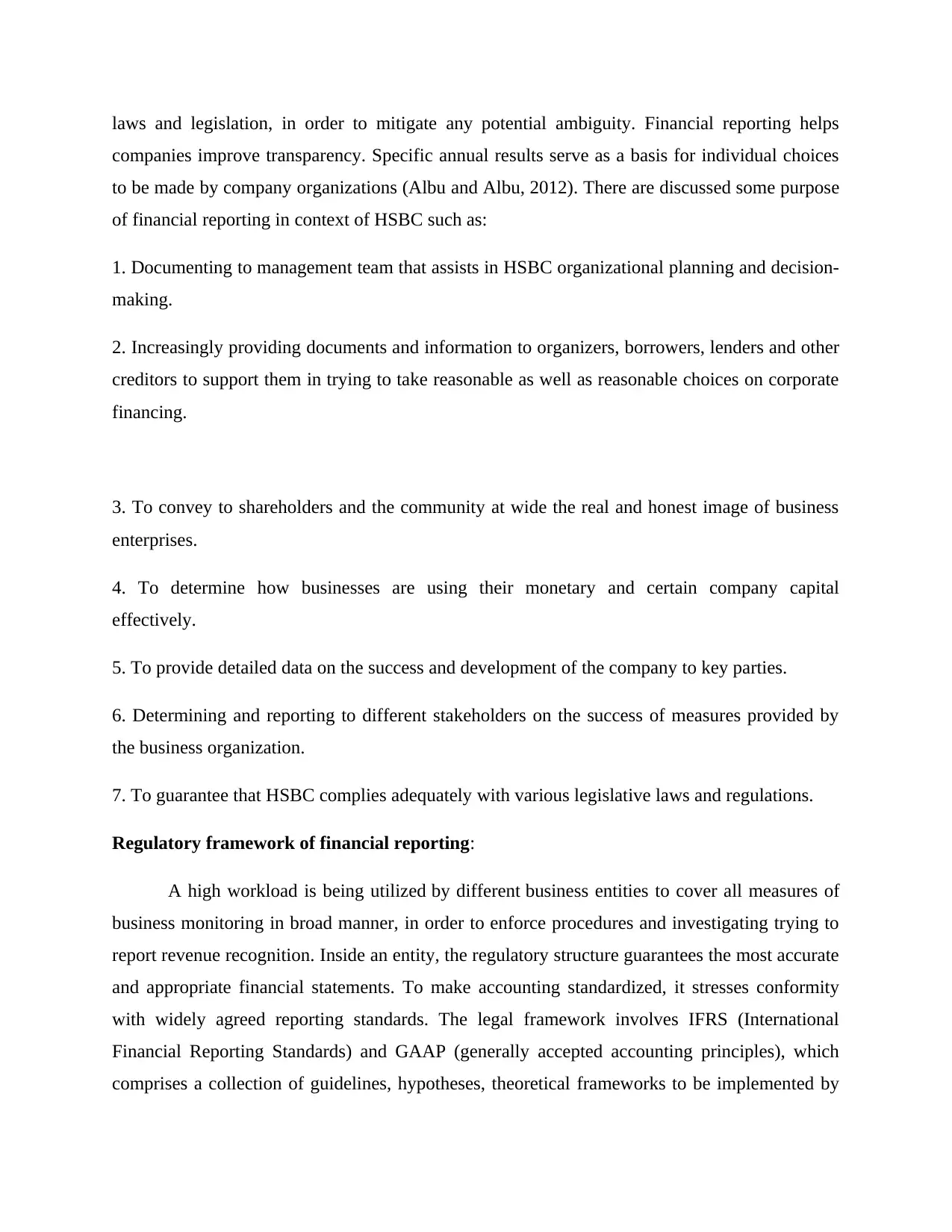
laws and legislation, in order to mitigate any potential ambiguity. Financial reporting helps
companies improve transparency. Specific annual results serve as a basis for individual choices
to be made by company organizations (Albu and Albu, 2012). There are discussed some purpose
of financial reporting in context of HSBC such as:
1. Documenting to management team that assists in HSBC organizational planning and decision-
making.
2. Increasingly providing documents and information to organizers, borrowers, lenders and other
creditors to support them in trying to take reasonable as well as reasonable choices on corporate
financing.
3. To convey to shareholders and the community at wide the real and honest image of business
enterprises.
4. To determine how businesses are using their monetary and certain company capital
effectively.
5. To provide detailed data on the success and development of the company to key parties.
6. Determining and reporting to different stakeholders on the success of measures provided by
the business organization.
7. To guarantee that HSBC complies adequately with various legislative laws and regulations.
Regulatory framework of financial reporting:
A high workload is being utilized by different business entities to cover all measures of
business monitoring in broad manner, in order to enforce procedures and investigating trying to
report revenue recognition. Inside an entity, the regulatory structure guarantees the most accurate
and appropriate financial statements. To make accounting standardized, it stresses conformity
with widely agreed reporting standards. The legal framework involves IFRS (International
Financial Reporting Standards) and GAAP (generally accepted accounting principles), which
comprises a collection of guidelines, hypotheses, theoretical frameworks to be implemented by
companies improve transparency. Specific annual results serve as a basis for individual choices
to be made by company organizations (Albu and Albu, 2012). There are discussed some purpose
of financial reporting in context of HSBC such as:
1. Documenting to management team that assists in HSBC organizational planning and decision-
making.
2. Increasingly providing documents and information to organizers, borrowers, lenders and other
creditors to support them in trying to take reasonable as well as reasonable choices on corporate
financing.
3. To convey to shareholders and the community at wide the real and honest image of business
enterprises.
4. To determine how businesses are using their monetary and certain company capital
effectively.
5. To provide detailed data on the success and development of the company to key parties.
6. Determining and reporting to different stakeholders on the success of measures provided by
the business organization.
7. To guarantee that HSBC complies adequately with various legislative laws and regulations.
Regulatory framework of financial reporting:
A high workload is being utilized by different business entities to cover all measures of
business monitoring in broad manner, in order to enforce procedures and investigating trying to
report revenue recognition. Inside an entity, the regulatory structure guarantees the most accurate
and appropriate financial statements. To make accounting standardized, it stresses conformity
with widely agreed reporting standards. The legal framework involves IFRS (International
Financial Reporting Standards) and GAAP (generally accepted accounting principles), which
comprises a collection of guidelines, hypotheses, theoretical frameworks to be implemented by
Paraphrase This Document
Need a fresh take? Get an instant paraphrase of this document with our AI Paraphraser
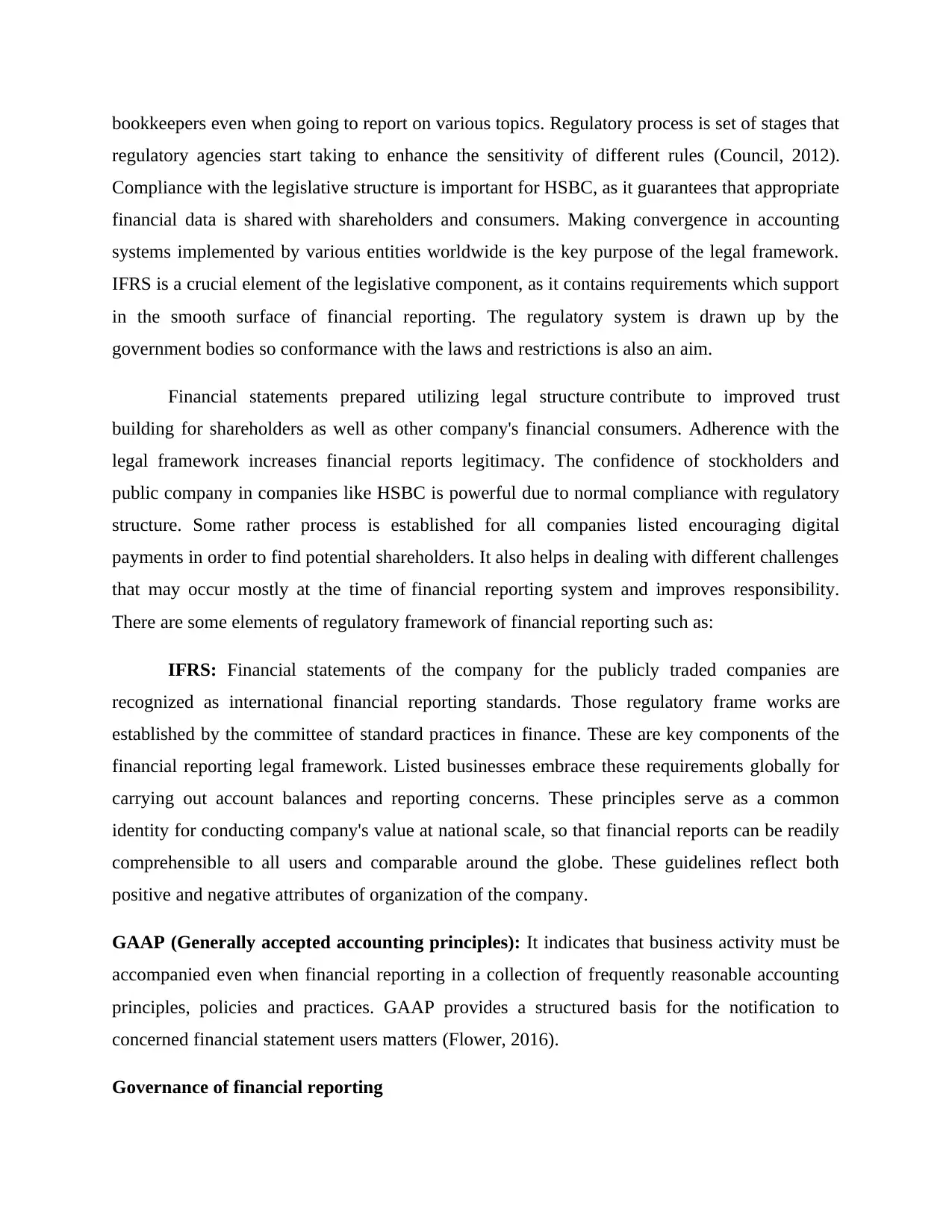
bookkeepers even when going to report on various topics. Regulatory process is set of stages that
regulatory agencies start taking to enhance the sensitivity of different rules (Council, 2012).
Compliance with the legislative structure is important for HSBC, as it guarantees that appropriate
financial data is shared with shareholders and consumers. Making convergence in accounting
systems implemented by various entities worldwide is the key purpose of the legal framework.
IFRS is a crucial element of the legislative component, as it contains requirements which support
in the smooth surface of financial reporting. The regulatory system is drawn up by the
government bodies so conformance with the laws and restrictions is also an aim.
Financial statements prepared utilizing legal structure contribute to improved trust
building for shareholders as well as other company's financial consumers. Adherence with the
legal framework increases financial reports legitimacy. The confidence of stockholders and
public company in companies like HSBC is powerful due to normal compliance with regulatory
structure. Some rather process is established for all companies listed encouraging digital
payments in order to find potential shareholders. It also helps in dealing with different challenges
that may occur mostly at the time of financial reporting system and improves responsibility.
There are some elements of regulatory framework of financial reporting such as:
IFRS: Financial statements of the company for the publicly traded companies are
recognized as international financial reporting standards. Those regulatory frame works are
established by the committee of standard practices in finance. These are key components of the
financial reporting legal framework. Listed businesses embrace these requirements globally for
carrying out account balances and reporting concerns. These principles serve as a common
identity for conducting company's value at national scale, so that financial reports can be readily
comprehensible to all users and comparable around the globe. These guidelines reflect both
positive and negative attributes of organization of the company.
GAAP (Generally accepted accounting principles): It indicates that business activity must be
accompanied even when financial reporting in a collection of frequently reasonable accounting
principles, policies and practices. GAAP provides a structured basis for the notification to
concerned financial statement users matters (Flower, 2016).
Governance of financial reporting
regulatory agencies start taking to enhance the sensitivity of different rules (Council, 2012).
Compliance with the legislative structure is important for HSBC, as it guarantees that appropriate
financial data is shared with shareholders and consumers. Making convergence in accounting
systems implemented by various entities worldwide is the key purpose of the legal framework.
IFRS is a crucial element of the legislative component, as it contains requirements which support
in the smooth surface of financial reporting. The regulatory system is drawn up by the
government bodies so conformance with the laws and restrictions is also an aim.
Financial statements prepared utilizing legal structure contribute to improved trust
building for shareholders as well as other company's financial consumers. Adherence with the
legal framework increases financial reports legitimacy. The confidence of stockholders and
public company in companies like HSBC is powerful due to normal compliance with regulatory
structure. Some rather process is established for all companies listed encouraging digital
payments in order to find potential shareholders. It also helps in dealing with different challenges
that may occur mostly at the time of financial reporting system and improves responsibility.
There are some elements of regulatory framework of financial reporting such as:
IFRS: Financial statements of the company for the publicly traded companies are
recognized as international financial reporting standards. Those regulatory frame works are
established by the committee of standard practices in finance. These are key components of the
financial reporting legal framework. Listed businesses embrace these requirements globally for
carrying out account balances and reporting concerns. These principles serve as a common
identity for conducting company's value at national scale, so that financial reports can be readily
comprehensible to all users and comparable around the globe. These guidelines reflect both
positive and negative attributes of organization of the company.
GAAP (Generally accepted accounting principles): It indicates that business activity must be
accompanied even when financial reporting in a collection of frequently reasonable accounting
principles, policies and practices. GAAP provides a structured basis for the notification to
concerned financial statement users matters (Flower, 2016).
Governance of financial reporting
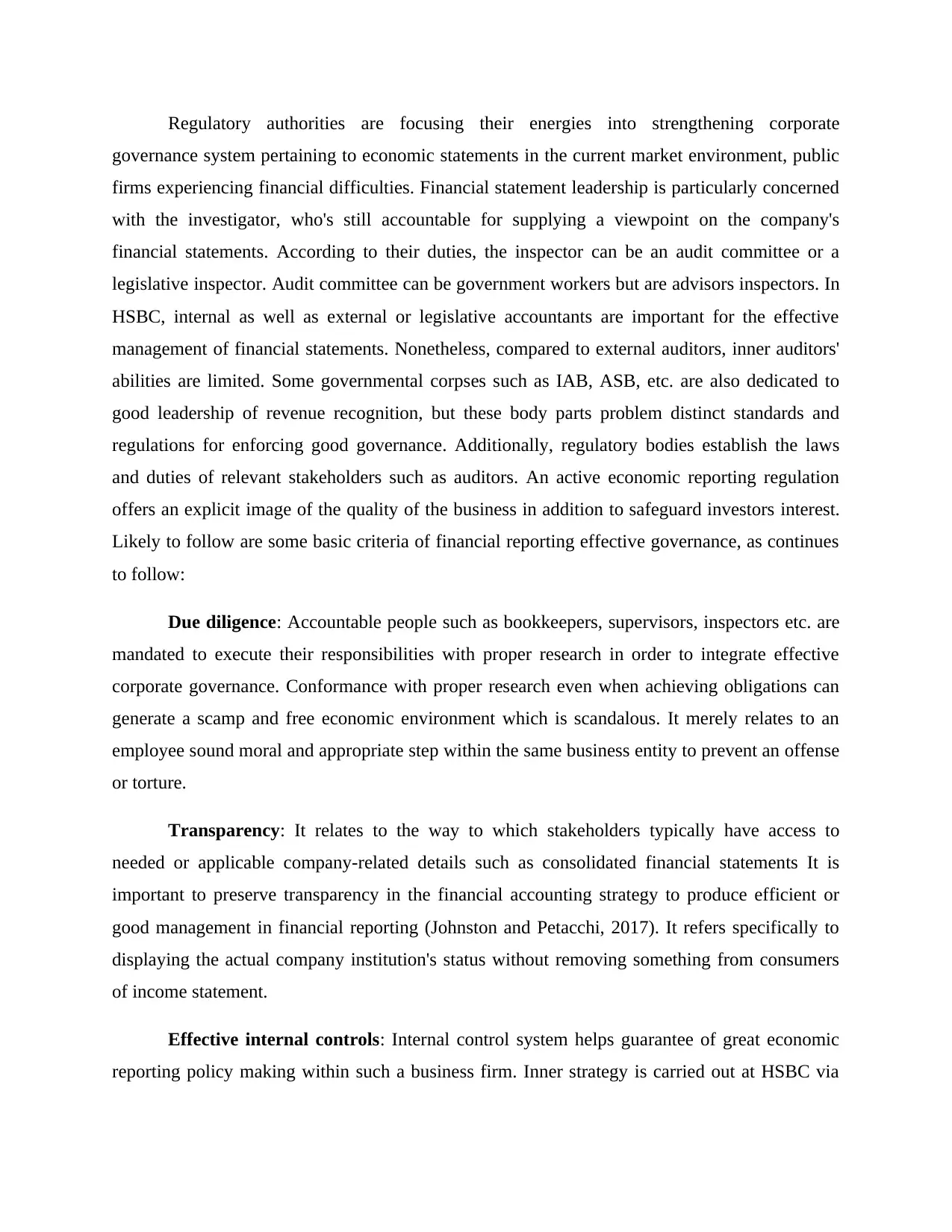
Regulatory authorities are focusing their energies into strengthening corporate
governance system pertaining to economic statements in the current market environment, public
firms experiencing financial difficulties. Financial statement leadership is particularly concerned
with the investigator, who's still accountable for supplying a viewpoint on the company's
financial statements. According to their duties, the inspector can be an audit committee or a
legislative inspector. Audit committee can be government workers but are advisors inspectors. In
HSBC, internal as well as external or legislative accountants are important for the effective
management of financial statements. Nonetheless, compared to external auditors, inner auditors'
abilities are limited. Some governmental corpses such as IAB, ASB, etc. are also dedicated to
good leadership of revenue recognition, but these body parts problem distinct standards and
regulations for enforcing good governance. Additionally, regulatory bodies establish the laws
and duties of relevant stakeholders such as auditors. An active economic reporting regulation
offers an explicit image of the quality of the business in addition to safeguard investors interest.
Likely to follow are some basic criteria of financial reporting effective governance, as continues
to follow:
Due diligence: Accountable people such as bookkeepers, supervisors, inspectors etc. are
mandated to execute their responsibilities with proper research in order to integrate effective
corporate governance. Conformance with proper research even when achieving obligations can
generate a scamp and free economic environment which is scandalous. It merely relates to an
employee sound moral and appropriate step within the same business entity to prevent an offense
or torture.
Transparency: It relates to the way to which stakeholders typically have access to
needed or applicable company-related details such as consolidated financial statements It is
important to preserve transparency in the financial accounting strategy to produce efficient or
good management in financial reporting (Johnston and Petacchi, 2017). It refers specifically to
displaying the actual company institution's status without removing something from consumers
of income statement.
Effective internal controls: Internal control system helps guarantee of great economic
reporting policy making within such a business firm. Inner strategy is carried out at HSBC via
governance system pertaining to economic statements in the current market environment, public
firms experiencing financial difficulties. Financial statement leadership is particularly concerned
with the investigator, who's still accountable for supplying a viewpoint on the company's
financial statements. According to their duties, the inspector can be an audit committee or a
legislative inspector. Audit committee can be government workers but are advisors inspectors. In
HSBC, internal as well as external or legislative accountants are important for the effective
management of financial statements. Nonetheless, compared to external auditors, inner auditors'
abilities are limited. Some governmental corpses such as IAB, ASB, etc. are also dedicated to
good leadership of revenue recognition, but these body parts problem distinct standards and
regulations for enforcing good governance. Additionally, regulatory bodies establish the laws
and duties of relevant stakeholders such as auditors. An active economic reporting regulation
offers an explicit image of the quality of the business in addition to safeguard investors interest.
Likely to follow are some basic criteria of financial reporting effective governance, as continues
to follow:
Due diligence: Accountable people such as bookkeepers, supervisors, inspectors etc. are
mandated to execute their responsibilities with proper research in order to integrate effective
corporate governance. Conformance with proper research even when achieving obligations can
generate a scamp and free economic environment which is scandalous. It merely relates to an
employee sound moral and appropriate step within the same business entity to prevent an offense
or torture.
Transparency: It relates to the way to which stakeholders typically have access to
needed or applicable company-related details such as consolidated financial statements It is
important to preserve transparency in the financial accounting strategy to produce efficient or
good management in financial reporting (Johnston and Petacchi, 2017). It refers specifically to
displaying the actual company institution's status without removing something from consumers
of income statement.
Effective internal controls: Internal control system helps guarantee of great economic
reporting policy making within such a business firm. Inner strategy is carried out at HSBC via
⊘ This is a preview!⊘
Do you want full access?
Subscribe today to unlock all pages.

Trusted by 1+ million students worldwide
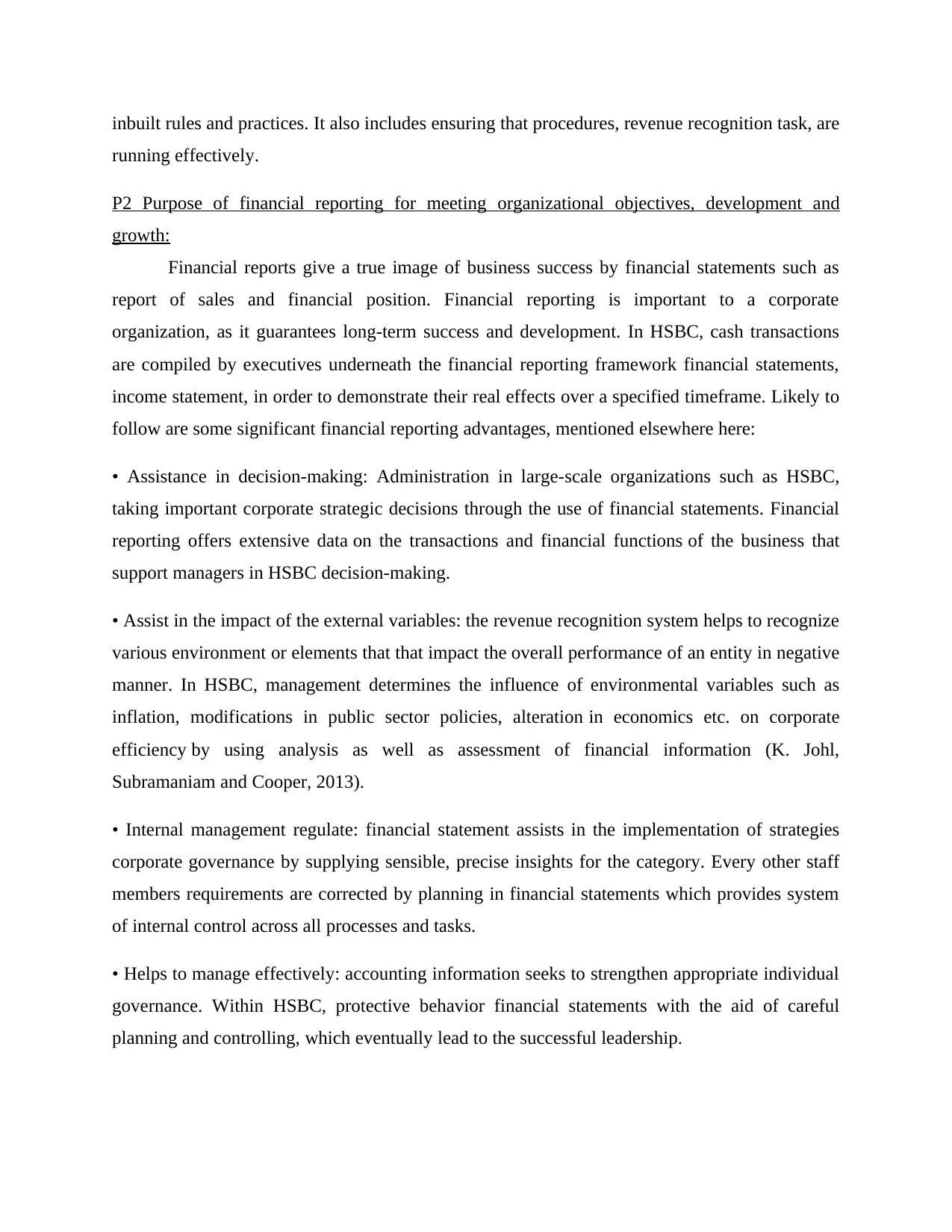
inbuilt rules and practices. It also includes ensuring that procedures, revenue recognition task, are
running effectively.
P2 Purpose of financial reporting for meeting organizational objectives, development and
growth:
Financial reports give a true image of business success by financial statements such as
report of sales and financial position. Financial reporting is important to a corporate
organization, as it guarantees long-term success and development. In HSBC, cash transactions
are compiled by executives underneath the financial reporting framework financial statements,
income statement, in order to demonstrate their real effects over a specified timeframe. Likely to
follow are some significant financial reporting advantages, mentioned elsewhere here:
• Assistance in decision-making: Administration in large-scale organizations such as HSBC,
taking important corporate strategic decisions through the use of financial statements. Financial
reporting offers extensive data on the transactions and financial functions of the business that
support managers in HSBC decision-making.
• Assist in the impact of the external variables: the revenue recognition system helps to recognize
various environment or elements that that impact the overall performance of an entity in negative
manner. In HSBC, management determines the influence of environmental variables such as
inflation, modifications in public sector policies, alteration in economics etc. on corporate
efficiency by using analysis as well as assessment of financial information (K. Johl,
Subramaniam and Cooper, 2013).
• Internal management regulate: financial statement assists in the implementation of strategies
corporate governance by supplying sensible, precise insights for the category. Every other staff
members requirements are corrected by planning in financial statements which provides system
of internal control across all processes and tasks.
• Helps to manage effectively: accounting information seeks to strengthen appropriate individual
governance. Within HSBC, protective behavior financial statements with the aid of careful
planning and controlling, which eventually lead to the successful leadership.
running effectively.
P2 Purpose of financial reporting for meeting organizational objectives, development and
growth:
Financial reports give a true image of business success by financial statements such as
report of sales and financial position. Financial reporting is important to a corporate
organization, as it guarantees long-term success and development. In HSBC, cash transactions
are compiled by executives underneath the financial reporting framework financial statements,
income statement, in order to demonstrate their real effects over a specified timeframe. Likely to
follow are some significant financial reporting advantages, mentioned elsewhere here:
• Assistance in decision-making: Administration in large-scale organizations such as HSBC,
taking important corporate strategic decisions through the use of financial statements. Financial
reporting offers extensive data on the transactions and financial functions of the business that
support managers in HSBC decision-making.
• Assist in the impact of the external variables: the revenue recognition system helps to recognize
various environment or elements that that impact the overall performance of an entity in negative
manner. In HSBC, management determines the influence of environmental variables such as
inflation, modifications in public sector policies, alteration in economics etc. on corporate
efficiency by using analysis as well as assessment of financial information (K. Johl,
Subramaniam and Cooper, 2013).
• Internal management regulate: financial statement assists in the implementation of strategies
corporate governance by supplying sensible, precise insights for the category. Every other staff
members requirements are corrected by planning in financial statements which provides system
of internal control across all processes and tasks.
• Helps to manage effectively: accounting information seeks to strengthen appropriate individual
governance. Within HSBC, protective behavior financial statements with the aid of careful
planning and controlling, which eventually lead to the successful leadership.
Paraphrase This Document
Need a fresh take? Get an instant paraphrase of this document with our AI Paraphraser
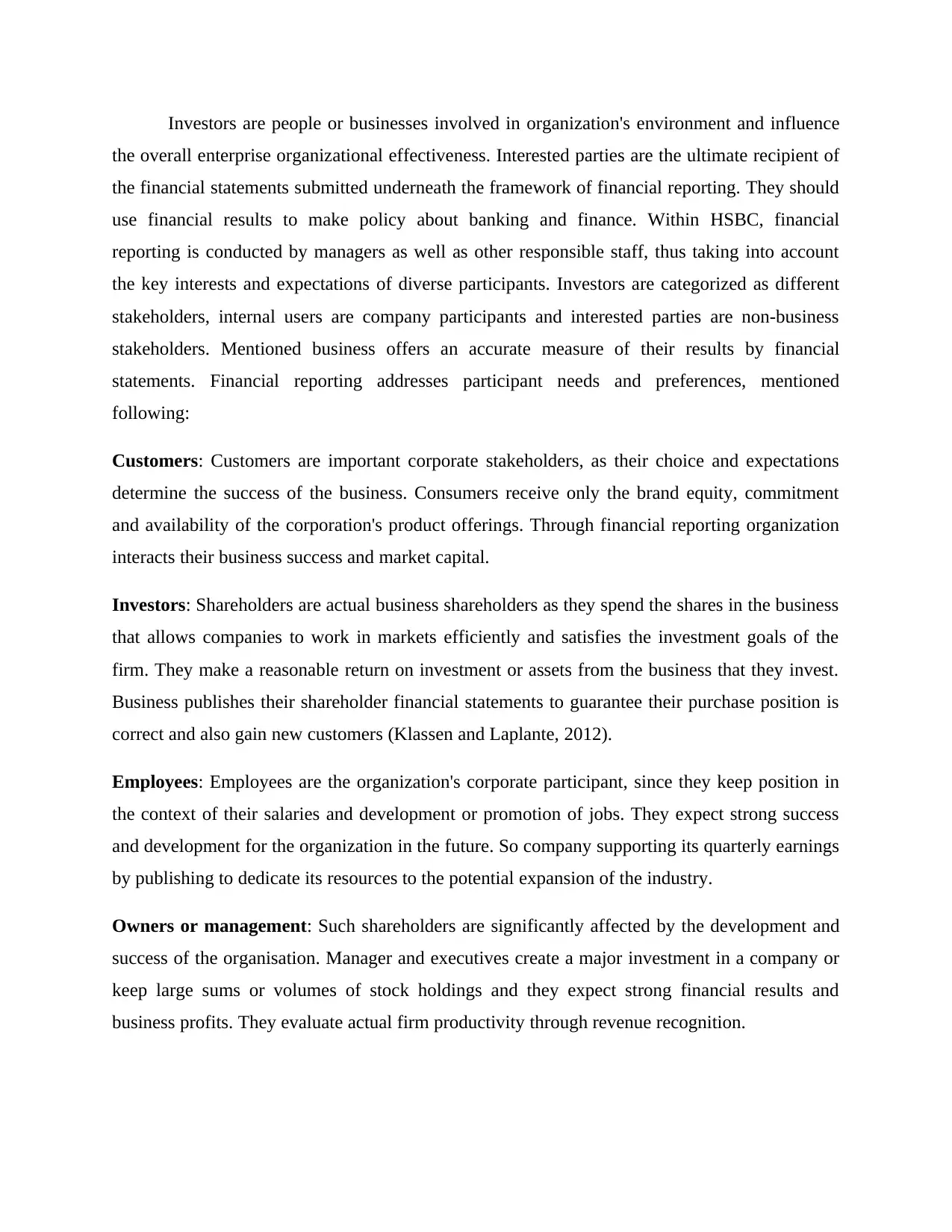
Investors are people or businesses involved in organization's environment and influence
the overall enterprise organizational effectiveness. Interested parties are the ultimate recipient of
the financial statements submitted underneath the framework of financial reporting. They should
use financial results to make policy about banking and finance. Within HSBC, financial
reporting is conducted by managers as well as other responsible staff, thus taking into account
the key interests and expectations of diverse participants. Investors are categorized as different
stakeholders, internal users are company participants and interested parties are non-business
stakeholders. Mentioned business offers an accurate measure of their results by financial
statements. Financial reporting addresses participant needs and preferences, mentioned
following:
Customers: Customers are important corporate stakeholders, as their choice and expectations
determine the success of the business. Consumers receive only the brand equity, commitment
and availability of the corporation's product offerings. Through financial reporting organization
interacts their business success and market capital.
Investors: Shareholders are actual business shareholders as they spend the shares in the business
that allows companies to work in markets efficiently and satisfies the investment goals of the
firm. They make a reasonable return on investment or assets from the business that they invest.
Business publishes their shareholder financial statements to guarantee their purchase position is
correct and also gain new customers (Klassen and Laplante, 2012).
Employees: Employees are the organization's corporate participant, since they keep position in
the context of their salaries and development or promotion of jobs. They expect strong success
and development for the organization in the future. So company supporting its quarterly earnings
by publishing to dedicate its resources to the potential expansion of the industry.
Owners or management: Such shareholders are significantly affected by the development and
success of the organisation. Manager and executives create a major investment in a company or
keep large sums or volumes of stock holdings and they expect strong financial results and
business profits. They evaluate actual firm productivity through revenue recognition.
the overall enterprise organizational effectiveness. Interested parties are the ultimate recipient of
the financial statements submitted underneath the framework of financial reporting. They should
use financial results to make policy about banking and finance. Within HSBC, financial
reporting is conducted by managers as well as other responsible staff, thus taking into account
the key interests and expectations of diverse participants. Investors are categorized as different
stakeholders, internal users are company participants and interested parties are non-business
stakeholders. Mentioned business offers an accurate measure of their results by financial
statements. Financial reporting addresses participant needs and preferences, mentioned
following:
Customers: Customers are important corporate stakeholders, as their choice and expectations
determine the success of the business. Consumers receive only the brand equity, commitment
and availability of the corporation's product offerings. Through financial reporting organization
interacts their business success and market capital.
Investors: Shareholders are actual business shareholders as they spend the shares in the business
that allows companies to work in markets efficiently and satisfies the investment goals of the
firm. They make a reasonable return on investment or assets from the business that they invest.
Business publishes their shareholder financial statements to guarantee their purchase position is
correct and also gain new customers (Klassen and Laplante, 2012).
Employees: Employees are the organization's corporate participant, since they keep position in
the context of their salaries and development or promotion of jobs. They expect strong success
and development for the organization in the future. So company supporting its quarterly earnings
by publishing to dedicate its resources to the potential expansion of the industry.
Owners or management: Such shareholders are significantly affected by the development and
success of the organisation. Manager and executives create a major investment in a company or
keep large sums or volumes of stock holdings and they expect strong financial results and
business profits. They evaluate actual firm productivity through revenue recognition.
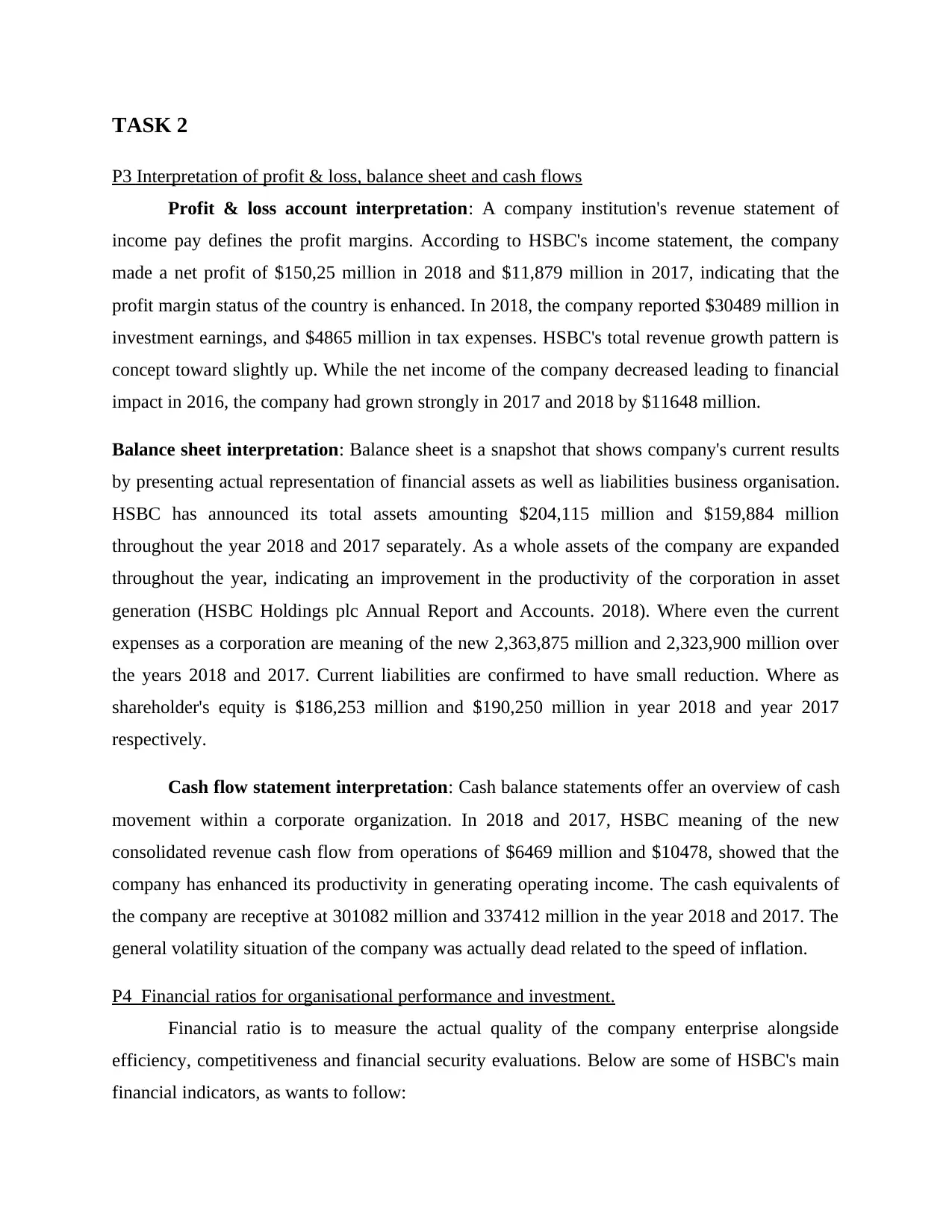
TASK 2
P3 Interpretation of profit & loss, balance sheet and cash flows
Profit & loss account interpretation: A company institution's revenue statement of
income pay defines the profit margins. According to HSBC's income statement, the company
made a net profit of $150,25 million in 2018 and $11,879 million in 2017, indicating that the
profit margin status of the country is enhanced. In 2018, the company reported $30489 million in
investment earnings, and $4865 million in tax expenses. HSBC's total revenue growth pattern is
concept toward slightly up. While the net income of the company decreased leading to financial
impact in 2016, the company had grown strongly in 2017 and 2018 by $11648 million.
Balance sheet interpretation: Balance sheet is a snapshot that shows company's current results
by presenting actual representation of financial assets as well as liabilities business organisation.
HSBC has announced its total assets amounting $204,115 million and $159,884 million
throughout the year 2018 and 2017 separately. As a whole assets of the company are expanded
throughout the year, indicating an improvement in the productivity of the corporation in asset
generation (HSBC Holdings plc Annual Report and Accounts. 2018). Where even the current
expenses as a corporation are meaning of the new 2,363,875 million and 2,323,900 million over
the years 2018 and 2017. Current liabilities are confirmed to have small reduction. Where as
shareholder's equity is $186,253 million and $190,250 million in year 2018 and year 2017
respectively.
Cash flow statement interpretation: Cash balance statements offer an overview of cash
movement within a corporate organization. In 2018 and 2017, HSBC meaning of the new
consolidated revenue cash flow from operations of $6469 million and $10478, showed that the
company has enhanced its productivity in generating operating income. The cash equivalents of
the company are receptive at 301082 million and 337412 million in the year 2018 and 2017. The
general volatility situation of the company was actually dead related to the speed of inflation.
P4 Financial ratios for organisational performance and investment.
Financial ratio is to measure the actual quality of the company enterprise alongside
efficiency, competitiveness and financial security evaluations. Below are some of HSBC's main
financial indicators, as wants to follow:
P3 Interpretation of profit & loss, balance sheet and cash flows
Profit & loss account interpretation: A company institution's revenue statement of
income pay defines the profit margins. According to HSBC's income statement, the company
made a net profit of $150,25 million in 2018 and $11,879 million in 2017, indicating that the
profit margin status of the country is enhanced. In 2018, the company reported $30489 million in
investment earnings, and $4865 million in tax expenses. HSBC's total revenue growth pattern is
concept toward slightly up. While the net income of the company decreased leading to financial
impact in 2016, the company had grown strongly in 2017 and 2018 by $11648 million.
Balance sheet interpretation: Balance sheet is a snapshot that shows company's current results
by presenting actual representation of financial assets as well as liabilities business organisation.
HSBC has announced its total assets amounting $204,115 million and $159,884 million
throughout the year 2018 and 2017 separately. As a whole assets of the company are expanded
throughout the year, indicating an improvement in the productivity of the corporation in asset
generation (HSBC Holdings plc Annual Report and Accounts. 2018). Where even the current
expenses as a corporation are meaning of the new 2,363,875 million and 2,323,900 million over
the years 2018 and 2017. Current liabilities are confirmed to have small reduction. Where as
shareholder's equity is $186,253 million and $190,250 million in year 2018 and year 2017
respectively.
Cash flow statement interpretation: Cash balance statements offer an overview of cash
movement within a corporate organization. In 2018 and 2017, HSBC meaning of the new
consolidated revenue cash flow from operations of $6469 million and $10478, showed that the
company has enhanced its productivity in generating operating income. The cash equivalents of
the company are receptive at 301082 million and 337412 million in the year 2018 and 2017. The
general volatility situation of the company was actually dead related to the speed of inflation.
P4 Financial ratios for organisational performance and investment.
Financial ratio is to measure the actual quality of the company enterprise alongside
efficiency, competitiveness and financial security evaluations. Below are some of HSBC's main
financial indicators, as wants to follow:
⊘ This is a preview!⊘
Do you want full access?
Subscribe today to unlock all pages.

Trusted by 1+ million students worldwide
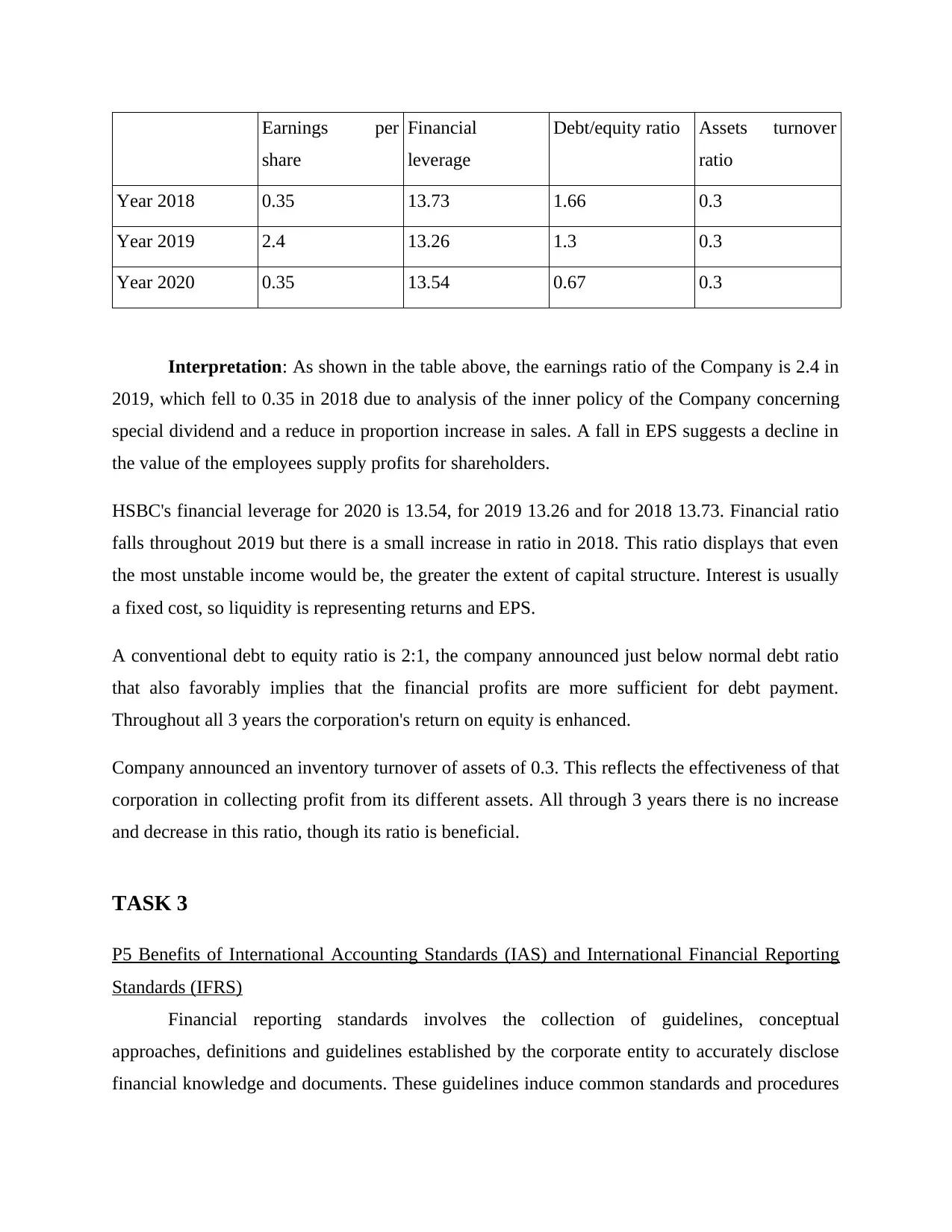
Earnings per
share
Financial
leverage
Debt/equity ratio Assets turnover
ratio
Year 2018 0.35 13.73 1.66 0.3
Year 2019 2.4 13.26 1.3 0.3
Year 2020 0.35 13.54 0.67 0.3
Interpretation: As shown in the table above, the earnings ratio of the Company is 2.4 in
2019, which fell to 0.35 in 2018 due to analysis of the inner policy of the Company concerning
special dividend and a reduce in proportion increase in sales. A fall in EPS suggests a decline in
the value of the employees supply profits for shareholders.
HSBC's financial leverage for 2020 is 13.54, for 2019 13.26 and for 2018 13.73. Financial ratio
falls throughout 2019 but there is a small increase in ratio in 2018. This ratio displays that even
the most unstable income would be, the greater the extent of capital structure. Interest is usually
a fixed cost, so liquidity is representing returns and EPS.
A conventional debt to equity ratio is 2:1, the company announced just below normal debt ratio
that also favorably implies that the financial profits are more sufficient for debt payment.
Throughout all 3 years the corporation's return on equity is enhanced.
Company announced an inventory turnover of assets of 0.3. This reflects the effectiveness of that
corporation in collecting profit from its different assets. All through 3 years there is no increase
and decrease in this ratio, though its ratio is beneficial.
TASK 3
P5 Benefits of International Accounting Standards (IAS) and International Financial Reporting
Standards (IFRS)
Financial reporting standards involves the collection of guidelines, conceptual
approaches, definitions and guidelines established by the corporate entity to accurately disclose
financial knowledge and documents. These guidelines induce common standards and procedures
share
Financial
leverage
Debt/equity ratio Assets turnover
ratio
Year 2018 0.35 13.73 1.66 0.3
Year 2019 2.4 13.26 1.3 0.3
Year 2020 0.35 13.54 0.67 0.3
Interpretation: As shown in the table above, the earnings ratio of the Company is 2.4 in
2019, which fell to 0.35 in 2018 due to analysis of the inner policy of the Company concerning
special dividend and a reduce in proportion increase in sales. A fall in EPS suggests a decline in
the value of the employees supply profits for shareholders.
HSBC's financial leverage for 2020 is 13.54, for 2019 13.26 and for 2018 13.73. Financial ratio
falls throughout 2019 but there is a small increase in ratio in 2018. This ratio displays that even
the most unstable income would be, the greater the extent of capital structure. Interest is usually
a fixed cost, so liquidity is representing returns and EPS.
A conventional debt to equity ratio is 2:1, the company announced just below normal debt ratio
that also favorably implies that the financial profits are more sufficient for debt payment.
Throughout all 3 years the corporation's return on equity is enhanced.
Company announced an inventory turnover of assets of 0.3. This reflects the effectiveness of that
corporation in collecting profit from its different assets. All through 3 years there is no increase
and decrease in this ratio, though its ratio is beneficial.
TASK 3
P5 Benefits of International Accounting Standards (IAS) and International Financial Reporting
Standards (IFRS)
Financial reporting standards involves the collection of guidelines, conceptual
approaches, definitions and guidelines established by the corporate entity to accurately disclose
financial knowledge and documents. These guidelines induce common standards and procedures
Paraphrase This Document
Need a fresh take? Get an instant paraphrase of this document with our AI Paraphraser
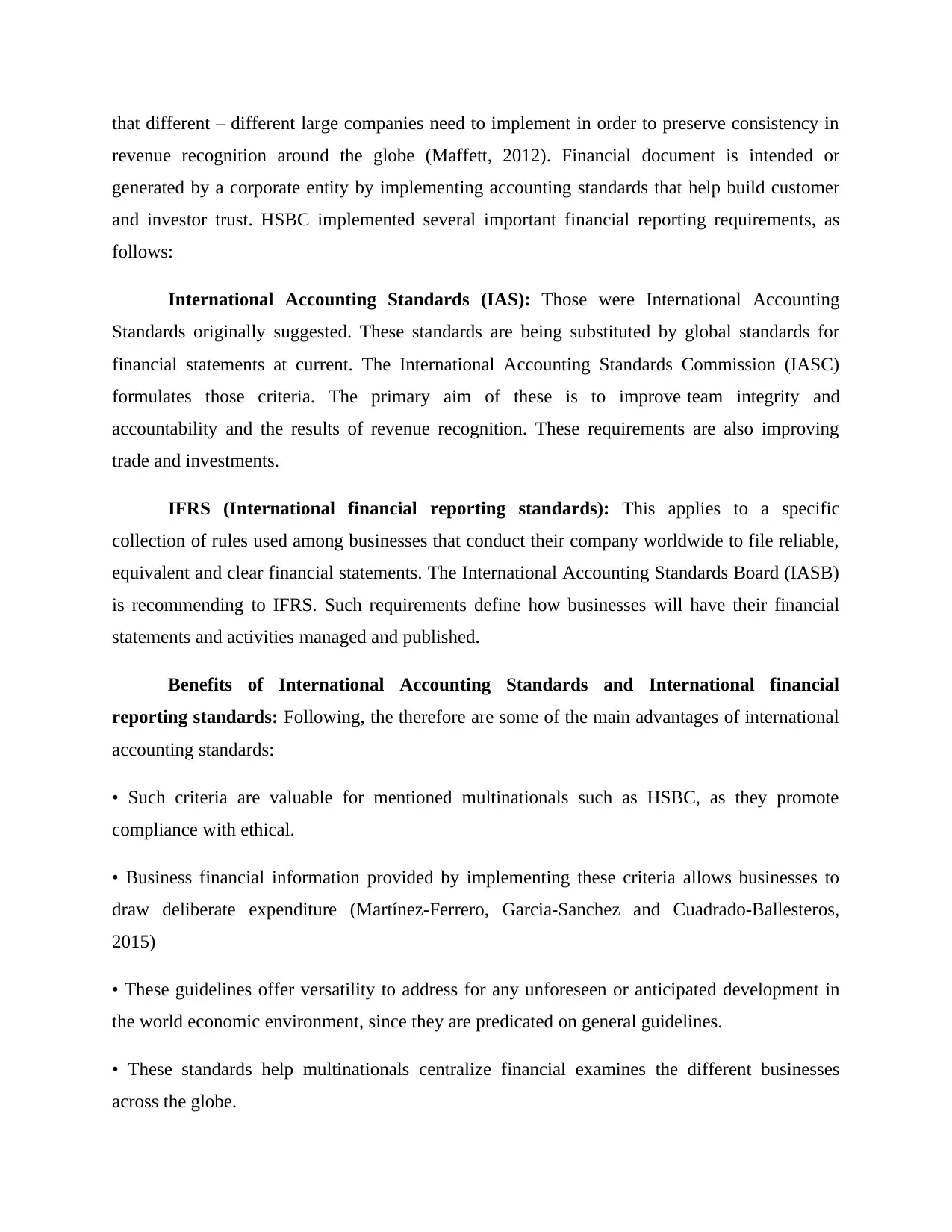
that different – different large companies need to implement in order to preserve consistency in
revenue recognition around the globe (Maffett, 2012). Financial document is intended or
generated by a corporate entity by implementing accounting standards that help build customer
and investor trust. HSBC implemented several important financial reporting requirements, as
follows:
International Accounting Standards (IAS): Those were International Accounting
Standards originally suggested. These standards are being substituted by global standards for
financial statements at current. The International Accounting Standards Commission (IASC)
formulates those criteria. The primary aim of these is to improve team integrity and
accountability and the results of revenue recognition. These requirements are also improving
trade and investments.
IFRS (International financial reporting standards): This applies to a specific
collection of rules used among businesses that conduct their company worldwide to file reliable,
equivalent and clear financial statements. The International Accounting Standards Board (IASB)
is recommending to IFRS. Such requirements define how businesses will have their financial
statements and activities managed and published.
Benefits of International Accounting Standards and International financial
reporting standards: Following, the therefore are some of the main advantages of international
accounting standards:
• Such criteria are valuable for mentioned multinationals such as HSBC, as they promote
compliance with ethical.
• Business financial information provided by implementing these criteria allows businesses to
draw deliberate expenditure (Martínez‐Ferrero, Garcia‐Sanchez and Cuadrado‐Ballesteros,
2015)
• These guidelines offer versatility to address for any unforeseen or anticipated development in
the world economic environment, since they are predicated on general guidelines.
• These standards help multinationals centralize financial examines the different businesses
across the globe.
revenue recognition around the globe (Maffett, 2012). Financial document is intended or
generated by a corporate entity by implementing accounting standards that help build customer
and investor trust. HSBC implemented several important financial reporting requirements, as
follows:
International Accounting Standards (IAS): Those were International Accounting
Standards originally suggested. These standards are being substituted by global standards for
financial statements at current. The International Accounting Standards Commission (IASC)
formulates those criteria. The primary aim of these is to improve team integrity and
accountability and the results of revenue recognition. These requirements are also improving
trade and investments.
IFRS (International financial reporting standards): This applies to a specific
collection of rules used among businesses that conduct their company worldwide to file reliable,
equivalent and clear financial statements. The International Accounting Standards Board (IASB)
is recommending to IFRS. Such requirements define how businesses will have their financial
statements and activities managed and published.
Benefits of International Accounting Standards and International financial
reporting standards: Following, the therefore are some of the main advantages of international
accounting standards:
• Such criteria are valuable for mentioned multinationals such as HSBC, as they promote
compliance with ethical.
• Business financial information provided by implementing these criteria allows businesses to
draw deliberate expenditure (Martínez‐Ferrero, Garcia‐Sanchez and Cuadrado‐Ballesteros,
2015)
• These guidelines offer versatility to address for any unforeseen or anticipated development in
the world economic environment, since they are predicated on general guidelines.
• These standards help multinationals centralize financial examines the different businesses
across the globe.
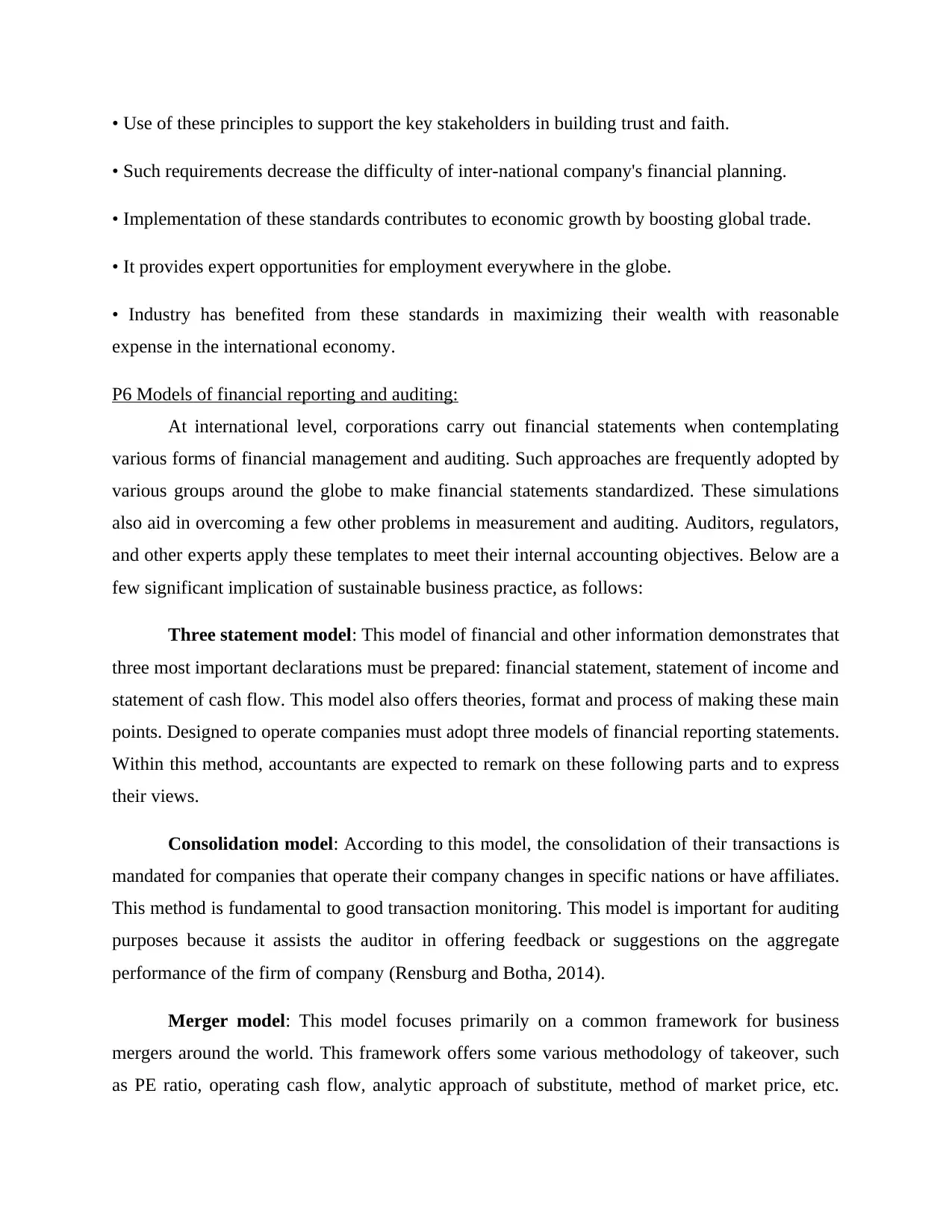
• Use of these principles to support the key stakeholders in building trust and faith.
• Such requirements decrease the difficulty of inter-national company's financial planning.
• Implementation of these standards contributes to economic growth by boosting global trade.
• It provides expert opportunities for employment everywhere in the globe.
• Industry has benefited from these standards in maximizing their wealth with reasonable
expense in the international economy.
P6 Models of financial reporting and auditing:
At international level, corporations carry out financial statements when contemplating
various forms of financial management and auditing. Such approaches are frequently adopted by
various groups around the globe to make financial statements standardized. These simulations
also aid in overcoming a few other problems in measurement and auditing. Auditors, regulators,
and other experts apply these templates to meet their internal accounting objectives. Below are a
few significant implication of sustainable business practice, as follows:
Three statement model: This model of financial and other information demonstrates that
three most important declarations must be prepared: financial statement, statement of income and
statement of cash flow. This model also offers theories, format and process of making these main
points. Designed to operate companies must adopt three models of financial reporting statements.
Within this method, accountants are expected to remark on these following parts and to express
their views.
Consolidation model: According to this model, the consolidation of their transactions is
mandated for companies that operate their company changes in specific nations or have affiliates.
This method is fundamental to good transaction monitoring. This model is important for auditing
purposes because it assists the auditor in offering feedback or suggestions on the aggregate
performance of the firm of company (Rensburg and Botha, 2014).
Merger model: This model focuses primarily on a common framework for business
mergers around the world. This framework offers some various methodology of takeover, such
as PE ratio, operating cash flow, analytic approach of substitute, method of market price, etc.
• Such requirements decrease the difficulty of inter-national company's financial planning.
• Implementation of these standards contributes to economic growth by boosting global trade.
• It provides expert opportunities for employment everywhere in the globe.
• Industry has benefited from these standards in maximizing their wealth with reasonable
expense in the international economy.
P6 Models of financial reporting and auditing:
At international level, corporations carry out financial statements when contemplating
various forms of financial management and auditing. Such approaches are frequently adopted by
various groups around the globe to make financial statements standardized. These simulations
also aid in overcoming a few other problems in measurement and auditing. Auditors, regulators,
and other experts apply these templates to meet their internal accounting objectives. Below are a
few significant implication of sustainable business practice, as follows:
Three statement model: This model of financial and other information demonstrates that
three most important declarations must be prepared: financial statement, statement of income and
statement of cash flow. This model also offers theories, format and process of making these main
points. Designed to operate companies must adopt three models of financial reporting statements.
Within this method, accountants are expected to remark on these following parts and to express
their views.
Consolidation model: According to this model, the consolidation of their transactions is
mandated for companies that operate their company changes in specific nations or have affiliates.
This method is fundamental to good transaction monitoring. This model is important for auditing
purposes because it assists the auditor in offering feedback or suggestions on the aggregate
performance of the firm of company (Rensburg and Botha, 2014).
Merger model: This model focuses primarily on a common framework for business
mergers around the world. This framework offers some various methodology of takeover, such
as PE ratio, operating cash flow, analytic approach of substitute, method of market price, etc.
⊘ This is a preview!⊘
Do you want full access?
Subscribe today to unlock all pages.

Trusted by 1+ million students worldwide
1 out of 20
Related Documents
Your All-in-One AI-Powered Toolkit for Academic Success.
+13062052269
info@desklib.com
Available 24*7 on WhatsApp / Email
![[object Object]](/_next/static/media/star-bottom.7253800d.svg)
Unlock your academic potential
Copyright © 2020–2025 A2Z Services. All Rights Reserved. Developed and managed by ZUCOL.





